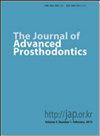悬臂种植体支架数字化制造技术对基牙螺钉预紧力的影响
IF 2.7
3区 医学
Q1 DENTISTRY, ORAL SURGERY & MEDICINE
引用次数: 0
摘要
本研究的目的是研究使用不同数字化制造技术制造的带悬臂的种植体支撑固定义齿(ICFDP)在种植体-基牙连接处的错位和螺钉预载,并比较循环加载前后的螺钉预载。材料和方法用数字扫描仪对四个孔内种植体的下颌模型进行扫描。立体光刻文件用于设计一个具有非咬合(NE)基牙和一个末端植入物远端10mm悬臂的框架。五个框架使用组合数字传统技术(CAD铸造)构建,五个框架采用三维打印(3DP)构建。以确保被动配合(PF)用作控制的方式构建了额外的CAD铸造框架。扫描电子显微镜(SEM)测量了种植体-基牙连接的错位。在相应的框架上使用了60个螺钉。扭转螺钉并记录循环前加载反向扭矩值(RTV)。对框架进行200000次加载循环,加载点距离邻近悬臂的末端植入物中心9mm,并记录循环后加载RTV。结果显微镜读数显示不同框架之间存在显著差异。PF的最低测量值为16.04(2.6)µm,而CAD铸件的最高测量值为29.2(3.1)µm。在所有组中,RTV均显著低于施加的扭矩。在PF和3DP框架中,循环后加载RTV显著低于循环前加载RTV。三种制造技术之间的RTV差异不显著。结论尽管CAD铸造和三维打印(3DP)都能产生临床可接受的错配框架,但3DP可能不是在剧烈载荷情况下保持螺钉预载稳定性的首选技术。本文章由计算机程序翻译,如有差异,请以英文原文为准。
The effect of the digital manufacturing technique of cantilevered implant-supported frameworks on abutment screw preload
PURPOSE The purpose of this study was to investigate the misfit and screw preload at the implant abutment connection of implant supported fixed dental prosthesis with cantilever (ICFDP) manufactured using different digital manufacturing techniques and to compare the screw preload before and after cyclic loading. MATERIALS AND METHODS Mandibular jaw model with four intra-foraminal implants was scanned using digital scanner. Stereolithography file was used to design a framework with nonengaging (NE) abutments and 10 mm cantilever distal to one terminal implant. Five frameworks were constructed using combined digital-conventional techniques (CAD-cast), and five frameworks were constructed using three-dimensional printing (3DP). Additional CAD-cast framework was constructed in a way that ensures passive fit (PF) to use as control. Scanning electron microscope (SEM) measured the implant abutment connection misfit. Sixty screws were used on the corresponding frameworks. Screws were torqued and pre-cyclic loading reverse torque value (RTV) was recorded. Frameworks were subjected to 200,000 loading cycles with a loading point 9 mm from the center of terminal implants adjacent to the cantilever and post-cyclic loading RTVs were recorded. RESULTS Microscopic readings showed significant differences between frameworks. PF demonstrated the lowest measurements of 16.04 (2.6) µm while CAD-cast demonstrated the highest measurements of 29.2 (3.1) µm. In all groups, RTVs were significantly lower than the applied torque. Post-cyclic loading RTV was significantly lower than pre-cyclic loading RTV in PF and 3DP frameworks. Differences in RTVs between the three manufacturing techniques were insignificant. CONCLUSION Although CAD-cast and three-dimensionally printed (3DP) both produce frameworks with clinically acceptable misfit, 3DP might not be the technique of choice for maintaining screw’s preload stability under an aggressive loading situation.
求助全文
通过发布文献求助,成功后即可免费获取论文全文。
去求助
来源期刊

Journal of Advanced Prosthodontics
DENTISTRY, ORAL SURGERY & MEDICINE-
CiteScore
4.70
自引率
3.80%
发文量
25
期刊介绍:
This journal aims to convey scientific and clinical progress in the field of prosthodontics and its related areas to many dental communities concerned with esthetic and functional restorations, occlusion, implants, prostheses, and biomaterials related to prosthodontics.
This journal publishes
• Original research data of high scientific merit in the field of diagnosis, function, esthetics and stomatognathic physiology related to prosthodontic rehabilitation, physiology and mechanics of occlusion, mechanical and biologic aspects of prosthodontic materials including dental implants.
• Review articles by experts on controversies and new developments in prosthodontics.
• Case reports if they provide or document new fundamental knowledge.
 求助内容:
求助内容: 应助结果提醒方式:
应助结果提醒方式:


